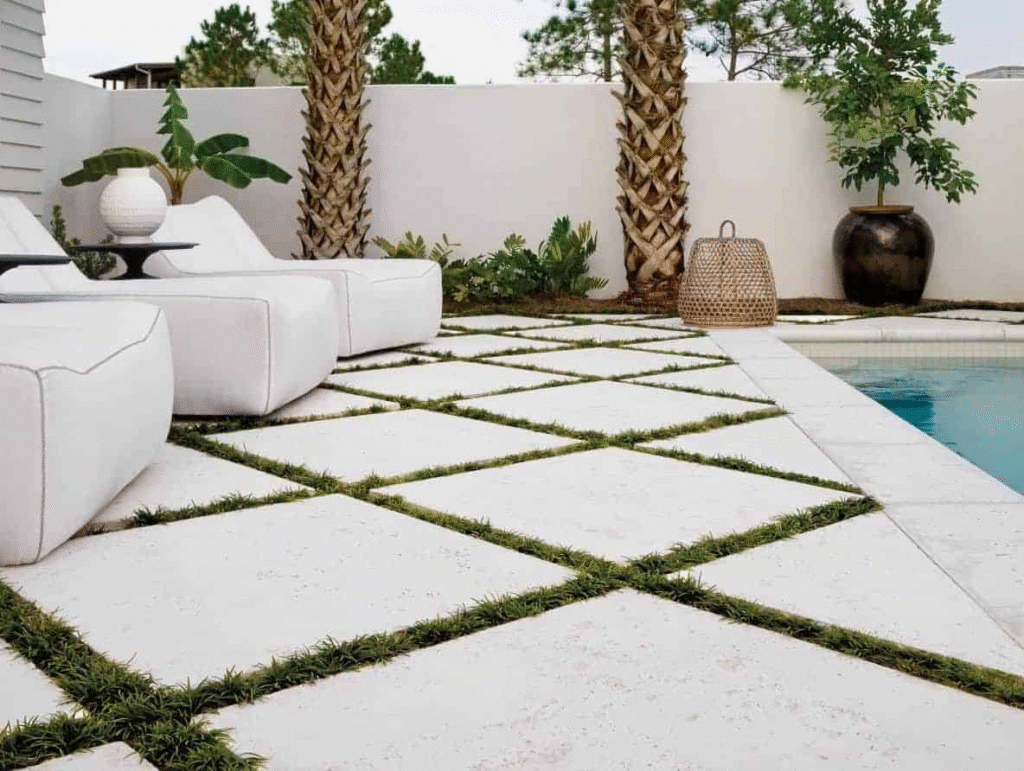I discovered the tell-tale orange freckles one spring morning while padding across the path to my raised beds. Overnight rain had splashed rusty water from a forgotten metal watering can onto the pale concrete pavers, and the stains seemed to laugh at my frantic scrub-brush attempts. After an hour of elbow grease and exactly zero progress, I poured myself a coffee, did some research, and set out to find methods that would lift the rust without harsh chemicals—or new stains on my conscience.

1. Why Rust Happens on Concrete (and Why It’s Stubborn)
Concrete is porous, a bit like a rigid sponge. When iron—think patio furniture legs, garden tools, metal edging—gets wet, it sheds microscopic iron oxide that seeps into surface pores. Because rust particles are both tiny and charged, plain water or detergent merely glides over them. Traditional concrete cleaners rely on strong acids that strip a thin layer of surface paste—effective, but gnarly for garden soil, pets, and your lungs.
Natural chemistry to the rescue
Mild household acids (citric, acetic) and natural chelators (oxalic acid found in many plants) loosen the ionic bond so stains can be scrubbed away or rinsed out—no haz-mat suit required.
2. Gear & Ingredients You’ll Need
| Item | Purpose | Notes |
|---|---|---|
| White vinegar (5–6 % acetic) | Primary rust dissolver | Substitute lemon juice if preferred |
| Baking soda | Neutralizer after acid | Prevents long-term etching |
| Fresh lemon / lime halves | Boosts acidity + light bleaching | Smells nicer than vinegar |
| Cream of tartar (optional) | Adds gentle abrasion | In pantry near spices |
| Old toothbrush or stiff nylon scrub brush | Mechanical aid | Avoid wire—it scratches |
| Microfiber or cotton rags | Wipe slurry & rinse | Dark colors hide rust residue |
| Bucket of clean water | Rinse + final neutralize | Hose works too |
| Rubber gloves | Skin protection | Even mild acids can dry skin |
Total cost if you don’t already have these: under $5.
3. Step-by-Step Method (Tested on My Own Stains)
Step 1 – Prep & Patch Test
- Sweep the paver to remove grit.
- Saturate a small corner of the stain with vinegar and let sit five minutes.
- Scrub lightly. If the spot lightens without bleaching the concrete, proceed.
(Concrete mixes vary; always test.)
Step 2 – Layer on the Acid
- Vinegar soak: Soak a rag in vinegar, lay it flat over the stain, and pour a little extra so it’s dripping but not puddling.
- Wait 20–30 minutes. Keep the rag moist; re-wet if necessary. You’ll smell vinegar barbecue—but resist scrubbing early. Time is the secret sauce.
Personal note: I fiddled with a timer while sipping lemonade on the porch. When the buzzer rang the orange halo had already haloed into a pale pink.
Step 3 – Scrub Gently
Remove the rag and sprinkle a pinch of baking soda onto the stain—this adds mild abrasion and begins neutralizing. Using the nylon brush, scrub in small circles. The slurry turns rusty brown; wipe with a damp cloth and inspect.
Step 4 – Citrus Boost (For Stubborn Spots)
For ghost shadows, cut a lemon in half, dip the cut end in salt or cream of tartar, and use it like a scouring pad for 60 seconds. Citric acid plus gentle grit often erases what vinegar alone misses.
Step 5 – Final Neutralize & Rinse
Sprinkle a broader dusting of baking soda, mist with water (it’ll fizz), then rinse thoroughly with the hose or bucket. The fizzing ensures no acidic residue keeps etching after you walk away.
Results
My worst blotch faded 90 % after the first round; a second vinegar soak erased it completely. Total active work time: ~15 minutes, mostly pleasant scrubbing therapy.
4. Natural Heavy-Hitters for Deep, Old Stains
If those orange freckles have matured into full-blown patches, escalate naturally:
- Oxalic acid powder (wood bleach)
Mix 2 Tbsp in 2 cups warm water. Brush on, sit 10 minutes, scrub, rinse. Oxalic acid is plant-derived (found in rhubarb leaves) but stronger than vinegar—wear gloves. - Rhubarb leaf paste
Old homesteader trick: Blend a handful of rhubarb leaves with just enough water to form a paste. The oxalic content is lower than powdered form but often plenty for lightly etched rust. - Ascorbic acid (vitamin C) tablets
Crush five tabs, add water to make a slurry, apply for 30 minutes. Bonus: safe around veggie beds.
Remember to neutralize with baking soda and rinse well after any acid treatment.
5. Common Mistakes & How to Avoid Them
| Mistake | Symptom | Fix / Prevention |
|---|---|---|
| Using a wire brush | Scratchy grey streaks or surface sheen | Switch to nylon; rust sits in pores, not on top |
| Letting acid dry | White crusty residue or uneven bleaching | Keep rags moist; if it dries, re-wet before scrubbing |
| Skipping neutralizer | Dull patch months later | Always follow with baking soda rinse |
| Treating heat-soaked concrete at noon | Rapid evaporation = low dwell time | Work mornings or shade area first |
6. Preventing Future Rust Stains
- Seal pavers – A breathable, water-based penetrating sealer blocks iron seepage while letting moisture out. Apply one coat every 2–3 years.
- Elevate metal – Slip rubber or plastic feet on patio furniture, place trays under steel planters, and store tools vertically.
- Rinse proactively – After rain, hose down areas under metal objects before rust can oxidize deeply.
- Rotate décor – Moving that vintage watering can weekly stops localized seep and adds visual variety.
My own path now hosts rubber-tipped bistro chairs; rust never sleeps, but a 10-cent foot pad keeps it from moving in.
7. Seasonal Maintenance Cheat Sheet
| Season | Quick Task | Time | Why |
|---|---|---|---|
| Spring | Inspect stepping-stones during first mow | 5 min | Catch new rust early |
| Summer | Vinegar wipe under grill cart after storms | 2 min | Prevents hot-weather oxidation |
| Autumn | Seal pavers before leaf-drop | 30 min | Sealant cures faster in mild temps |
| Winter | Store metal décor indoors or on bricks | 10 min | Rain + freeze cycles accelerate stains |
8. FAQs
Q: Will vinegar hurt surrounding grass or flowers?
A: Small splashes dilute quickly and act like fertilizer. Heavy spillage can temporarily lower soil pH—rinse excess off plants.
Q: My concrete is colored/stamped—safe to use acids?
A: Yes, but test: pigments may lighten slightly. Stick with mild vinegar or lemon, limit dwell time, and neutralize well.
Q: What if vinegar smell lingers?
A: Sprinkle extra baking soda, let fizz, rinse. Odor vanishes once residue neutralizes.
9. Cost & Time Reality Check
| Item | Cost | Notes |
|---|---|---|
| Vinegar (1 qt) | $1.50 | Often already in pantry |
| Baking soda (½ cup) | $0.25 | |
| Lemon (2) | $0.80 | |
| Nylon brush | $3.00 | Reusable |
| Total | $5.55 | Versus $15–$20 for a quart of commercial rust acid |
Labor: One or two 15-minute sessions with podcast + sunshine.
10. My Final Takeaway
Concrete rust stains look intimidating, partly because they seem baked in. Yet the right blend of mild acids, patience, and a little scrubbing turns them into nothing more than a fleeting eyesore—and you never need to crack open a jug of industrial acid. Each time I stroll my path now, stain-free and flanked by basil planters, I remember that Saturday lesson: nature provides both the problem (iron, water) and the solution (vinegar, lemon, rhubarb). The key is matching chemistry to patience.
So roll up your sleeves, raid the pantry, and give your stepping-stones the citrus spa treatment they deserve. Your garden walkway—and the earthworms beneath—will thank you,.


